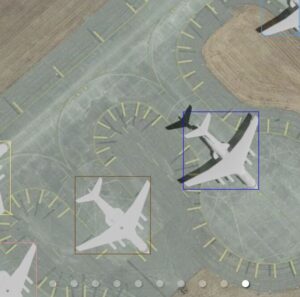TLDR: Russia’s use of painted fake planes to deceive AI highlights the need for robust computer vision. Synthetic data, like that generated by Rendered.ai, offers a powerful solution by enabling the creation of realistic training datasets to enhance AI’s ability to discern real from fake.
The recent news of Russia painting fake planes on airstrips to deceive computer vision systems serves as a stark reminder of the vulnerabilities inherent in AI models. This blatant act of tactical deception highlights the critical need for robust AI solutions, particularly in the field of computer vision.
One powerful answer to this challenge lies in synthetic data: the creation of artificial but realistic data used to train and improve AI models. While it may be difficult to get lots of real satellite images of planes painted on tarmac, it’s easy to create them to attempt to train and validate detection algorithms.
Platforms like Rendered.ai empower developers and businesses to generate high-quality synthetic datasets designed to address specific scenarios and challenges, such as obtaining enough unusual imagery quickly to train AI.

A synthetic image showing real and ‘painted on’ planes generated in Rendered.ai
Why Synthetic Data?
Traditional data collection methods often face limitations:
- Cost and Availability: Acquiring real-world data can be expensive and time-consuming, especially for complex situations or rare events.
- Privacy and Security Concerns: Capturing real-world data often raises ethical, security, and privacy concerns, prompting the need for alternatives.
- Data Bias: Real-world data can be biased based on its source and collection methods, leading to biased models that perpetuate those biases.
- Labeling Inaccuracy: Human labeling of data can be expensive and inaccurate, especially in cases where the expertise required (such as recognizing planes with or without shadows in fuzzy imagery) can be hard to find.
Synthetic data offers unique advantages:
- Scalability: Vast amounts of diverse data can be generated quickly and cost-effectively, catering to specific scenarios and edge cases.
- Control: Users have complete control over the data generated, ensuring consistency, eliminating bias, and protecting privacy.
- Customization: Synthetic data can be tailored to specific needs, allowing for the creation of highly relevant and realistic training datasets.
Visit the “Fake Planes in Satellite Imagery” Channel in our Sample Gallery when you sign up.
How Rendered.ai Makes Synthetic Data Simple
Rendered.ai provides a user-friendly platform to leverage the power of synthetic data. Here’s a simplified breakdown of the process:
- Define your synthetic data application: Specify the environment, objects, and conditions you want to simulate.
- Customize your data: Set parameters like lighting, weather, and object variations to enhance realism.
- Generate your dataset: Rendered.ai allows you to create and run synthetic data channels that generate high-quality images, videos, or 3D models based on your specifications.
- Train your AI model: Use your newly generated synthetic data to train and refine your computer vision model.
By implementing synthetic data with tools like Rendered.ai, developers and businesses can build robust AI models capable of discerning real from fake, mitigating the impact of potential deception tactics and ensuring greater accuracy in various computer vision applications.
Ready to get started? Explore the power of synthetic data in the “Fake Planes in Satellite Imagery” Channel in our Sample Gallery with a free trial of Rendered.ai.
Additionally, for more information on synthetic data and its benefits in computer vision, explore the resources below:
- An Executive’s Guide to Synthetic Data for Computer Vision
- Recent webinar on how Synthetic Data is revolutionizing Computer Vision





